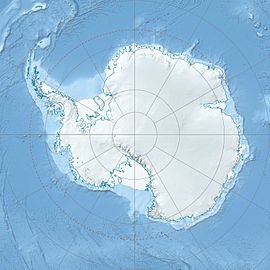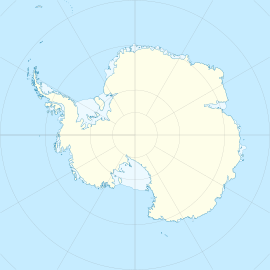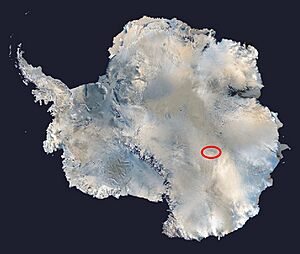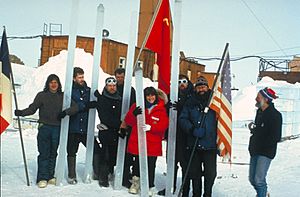Vostok Station facts for kids
Quick facts for kids
Vostok Station
ста́нция Восто́к
|
|
|---|---|
|
Antarctic base
|
|

Elevated photo of Vostok Station
|
|
| Country | |
| Location in Antarctica | Princess Elizabeth Land Antarctica |
| Administered by | Arctic and Antarctic Research Institute |
| Established | 16 December 1957 |
| Named for | Vostok |
| Elevation | 3,489 m (11,447 ft) |
| Population | |
| • Total | Up to 25 |
| Time zone | UTC+6 |
| Type | All-year round |
| Period | Annual |
| Status | Operational |
|
Vostok Skiway
|
|||||||||||
|---|---|---|---|---|---|---|---|---|---|---|---|
| Summary | |||||||||||
| Airport type | Private | ||||||||||
| Location | Princess Elizabeth Land | ||||||||||
| Elevation AMSL | 11,447 ft / 3,489 m | ||||||||||
| Coordinates | 78°27′58″S 106°50′54″E / 78.466139°S 106.84825°E | ||||||||||
| Map | |||||||||||
| Runway | |||||||||||
|
|||||||||||
Vostok Station (which means "Station East" in Russian) is a research station run by Russia. It is located deep inside Princess Elizabeth Land in Antarctica. The Soviet Union started the station in 1957. It is known as the southern Pole of Cold because it holds the record for the coldest natural temperature ever measured on Earth. This temperature was an incredible −89.2 °C (−128.6 °F; 184.0 K).
Scientists at Vostok Station study many things, including ice core drilling and magnetometry. The station was named after the ship Vostok. This ship was the main vessel of the First Russian Antarctic Expedition. Its captain was Fabian Gottlieb von Bellingshausen. Another station, Bellingshausen Station, is named after him. The second ship, Mirny, led by Mikhail Lazarev, gave its name to Mirny Station.
Contents
About Vostok Station
Vostok Research Station is about 1,301 kilometres (808 mi) away from the Geographic South Pole. It sits in the middle of the East Antarctic Ice Sheet.
The station is close to the Southern Pole of Inaccessibility. It is also near the South Geomagnetic Pole. This makes it a great place to study changes in Earth's magnetosphere. Other research includes actinometry (measuring radiation), geophysics, medicine, and climatology.
The station is 3,488 metres (11,444 ft) above sea level. This makes it one of the most isolated research stations in Antarctica. Supplies for Vostok Station come from Mirny Station on the Antarctic coast. In the summer, about 25 scientists and engineers work there. In winter, this number drops to 13 people.
The only permanent research station further south is the Amundsen–Scott South Pole Station. The United States operates this station right at the geographic South Pole. The Chinese Kunlun Station is even further south than Vostok. However, it is only used during the summer months.
Life at the station can be very challenging. Writer Vladimir Sanin described some of these challenges in his books. These include Newbie in the Antarctic (1973) and 72 Degrees Below Zero (1975).
History of Vostok Station
Vostok Station opened on December 16, 1957. This was during the International Geophysical Year. The 2nd Soviet Antarctic Expedition set it up. The station operated all year round for over 37 years. It was closed for short periods in 1962-1963, 1994, and during the winter of 2003.
In 1959, an unusual event happened at Vostok station. Two scientists had an argument over a game of chess. One scientist became very angry after losing and attacked the other. After this, chess games were not allowed at Soviet and Russian Antarctic stations.
Discovery of Lake Vostok
In 1974, British scientists used radar to look under the ice in Antarctica. They found strange readings at the Vostok site. At first, they didn't realize it was a huge freshwater lake. In 1991, Jeff Ridley, a scientist from University College London, used a European satellite called ERS-1. The satellite confirmed the discovery from 1974.
It wasn't until 1993 that the discovery was officially announced. Space radar showed that this hidden body of fresh water was one of the largest lakes in the world. It was also one of about 140 subglacial lakes found in Antarctica. Russian and British scientists mapped out Lake Vostok in 1996. They used radar images and satellite measurements. Lake Vostok is about 4,000 metres (13,000 ft) below the ice surface. It covers an area of 14,000 square kilometres (5,400 sq mi).
New Station Building
In 2019, Russia started building a new, modern station. This new building will replace the older facilities. It was built in St. Petersburg and was planned to be shipped to Vostok Station. However, there have been delays. The new station is now expected to be ready no earlier than 2023.
Historic Landmarks
- Vostok Station Tractor: A heavy tractor called АТТ 11 is a historic landmark. It was part of the first trip to the South Geomagnetic Pole. A plaque is also there to remember the station's opening in 1957. Russia suggested making this a Historic Site or Monument (HSM 11).
- Professor Kudryashov's Drilling Complex Building: This building is near Vostok Station at 3,488 metres (11,444 ft) elevation. It was built in 1983–1984. Under Professor Boris Kudryashov, very old ice core samples were taken from here. This building is also a Historic Site or Monument (HSM 88).
Climate at Vostok Station
Vostok Station has an ice cap climate. This means temperatures are below freezing all year round, which is common in Antarctica. It is one of the driest places on Earth. It only gets about 22 millimetres (0.87 in) of snow each year.
Vostok is also one of the sunniest places on Earth. Even though it has no sunshine from May to August, it gets more hours of sunshine per year than many sunny places. In December, Vostok gets an average of 708.8 hours of sunshine. That's about 22.9 hours every day! But during the polar night, it has zero hours of sunshine.
Of all the weather stations currently operating, Vostok is the coldest based on its average yearly temperature. However, some believe that Plateau Station, which is no longer active, might have been colder. Satellite readings have also shown even colder temperatures between Dome A and Dome F. The most recent record for October was set on October 1, 2021.
| Climate data for Vostok Station | |||||||||||||
|---|---|---|---|---|---|---|---|---|---|---|---|---|---|
| Month | Jan | Feb | Mar | Apr | May | Jun | Jul | Aug | Sep | Oct | Nov | Dec | Year |
| Record high °C (°F) | −14.0 (6.8) |
−21.0 (−5.8) |
−17.7 (0.1) |
−33.0 (−27.4) |
−38.0 (−36.4) |
−33.0 (−27.4) |
−34.1 (−29.4) |
−34.9 (−30.8) |
−34.3 (−29.7) |
−33.6 (−28.5) |
−24.3 (−11.7) |
−14.1 (6.6) |
−14.0 (6.8) |
| Mean daily maximum °C (°F) | −27.0 (−16.6) |
−38.7 (−37.7) |
−52.9 (−63.2) |
−61.1 (−78.0) |
−62.0 (−79.6) |
−60.6 (−77.1) |
−62.4 (−80.3) |
−63.9 (−83.0) |
−61.6 (−78.9) |
−51.5 (−60.7) |
−37.2 (−35.0) |
−27.1 (−16.8) |
−50.5 (−58.9) |
| Daily mean °C (°F) | −32.0 (−25.6) |
−44.3 (−47.7) |
−57.9 (−72.2) |
−64.8 (−84.6) |
−65.8 (−86.4) |
−65.3 (−85.5) |
−66.7 (−88.1) |
−67.9 (−90.2) |
−66.0 (−86.8) |
−57.1 (−70.8) |
−42.6 (−44.7) |
−31.8 (−25.2) |
−55.2 (−67.3) |
| Mean daily minimum °C (°F) | −37.5 (−35.5) |
−50.0 (−58.0) |
−61.8 (−79.2) |
−67.8 (−90.0) |
−69.1 (−92.4) |
−68.9 (−92.0) |
−70.4 (−94.7) |
−71.5 (−96.7) |
−70.2 (−94.4) |
−63.1 (−81.6) |
−49.8 (−57.6) |
−38.0 (−36.4) |
−59.8 (−75.7) |
| Record low °C (°F) | −56.4 (−69.5) |
−64.0 (−83.2) |
−75.3 (−103.5) |
−86.0 (−122.8) |
−81.2 (−114.2) |
−83.8 (−118.8) |
−89.2 (−128.6) |
−88.3 (−126.9) |
−85.9 (−122.6) |
−79.4 (−110.9) |
−63.9 (−83.0) |
−50.1 (−58.2) |
−89.2 (−128.6) |
| Average precipitation mm (inches) | 1.0 (0.04) |
0.7 (0.03) |
2.0 (0.08) |
2.4 (0.09) |
2.8 (0.11) |
2.5 (0.10) |
2.2 (0.09) |
2.3 (0.09) |
2.4 (0.09) |
1.9 (0.07) |
1.1 (0.04) |
0.7 (0.03) |
22 (0.86) |
| Average relative humidity (%) | 70.1 | 68.6 | 66.2 | 64.7 | 64.7 | 65.5 | 65.7 | 65.8 | 66.2 | 67.4 | 68.7 | 69.8 | 67.0 |
| Mean monthly sunshine hours | 696.4 | 566.8 | 347.3 | 76.3 | 0.0 | 0.0 | 0.0 | 0.0 | 203.4 | 480.2 | 682.3 | 708.8 | 3,761.5 |
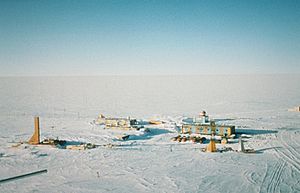
Vostok is one of the coldest places on Earth. The average temperature in the cold season (April to September) is about −66 °C (−87 °F). In the warm season (October to March), the average temperature is about −44 °C (−47 °F).
The lowest reliably measured temperature on Earth was −89.2 °C (−128.6 °F). This record was set at Vostok on July 21, 1983. This temperature beat the station's old record of −88.3 °C (−126.9 °F) from August 24, 1960. Even colder temperatures might occur higher up on the ice sheet.
The coldest wind chill ever recorded was −129 °C (−200 °F) on August 24, 2005. The actual temperature that day was −76.7 °C (−106.1 °F). It has also been reported that Vostok reached −91 °C (−132 °F) on July 28, 1997, but this is not officially confirmed.
The warmest temperature ever recorded at Vostok is −14.0 °C (6.8 °F). This happened on January 5, 1974. The coldest month was August 1987, with an average temperature of −75.4 °C (−103.7 °F). The warmest month was December 1989, with an average of −28 °C (−18 °F).
Challenges of Living at Vostok
Besides the extreme cold, other things make Vostok a very tough place for people to live:
- There is almost no moisture in the air.
- The average wind speed is 5 metres per second (11 mph; 18 km/h). Sometimes, winds can reach 27 metres per second (60 mph; 97 km/h).
- There is less oxygen in the air because of the high elevation of 3,488 metres (11,444 feet).
- The air has a higher ionization level.
- There is a polar night that lasts about 120 days. This is from late April to mid-September. For 85 of these days, it is too dark to read.
Getting used to these conditions can take from one week to two months. People might experience headaches, eye twitches, and ear pains. Other symptoms include nosebleeds, feeling like you can't breathe, and sudden increases in blood pressure. People might also have trouble sleeping, lose their appetite, vomit, and feel joint and muscle pain. Some even lose 3–5 kg (7–11 lb) of weight, or sometimes up to 12 kg (26 lb).
Ice Core Drilling at Vostok
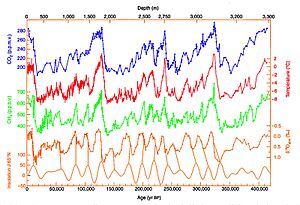
In the 1970s, the Soviet Union drilled several ice cores. These cores were between 500–952 metres (1,640–3,123 ft) deep. Scientists studied the oxygen in the ice. This showed that ice from the last ice age was found below 400 meters.
Later, three more holes were drilled:
- In 1984, Hole 3G reached 2,202 metres (7,224 ft).
- In 1990, Hole 4G reached 2,546 metres (8,353 ft).
- In 1993, Hole 5G reached 2,755 metres (9,039 ft).
Drilling continued in 1995. In 1996, it stopped at 3,623 metres (11,886 ft). This was because the Scientific Committee on Antarctic Research worried about possibly contaminating Lake Vostok. This ice core, drilled with French scientists, provided information about Earth's past climate. It covered 420,000 years and four past ice ages. For a long time, it was the only core to show several ice ages. In 2004, the EPICA core went even further back in time.
In 2003, drilling was allowed to continue. However, it stopped when it was only 130 metres (430 ft) away from the lake. The ancient lake was finally reached on February 5, 2012. Scientists stopped drilling at 3,770 metres (12,370 ft) and touched the surface of the hidden lake.
The "brittle zone" in the ice core is between 250 and 750 meters deep. This part of the core shows the time of the Last Glacial Maximum. The end of the Holocene climatic optimum is around 250 meters deep.
Even though the Vostok core reached 3,623 metres (11,886 ft), the useful climate information doesn't go that deep. The very bottom of the core is ice that refroze from Lake Vostok's water. This ice doesn't contain climate information. The usual data goes down to 3,310 metres (10,860 ft), or 414,000 years. Below this, the ice shows signs of being deformed. Some suggest the Vostok record could go down to 3,345 metres (10,974 ft), or 436,000 years. This would include more of the interesting MIS11 period. This extended record matches the newer, longer EPICA record.
Images for kids
-
Panoramic photo of Vostok Station showing the layout of the camp. The striped building on the left is the power station while the striped building on the right is where researchers sleep and take meals. The building in the background with the red- and white-striped ball on top is the meteorology building. Caves were dug into the ice sheet for storage, keeping cores at an ideal −55 °C (−67 °F) year-round. (Credit: Todd Sowers LDEO, Columbia University, Palisades, New York.)
See also
 In Spanish: Base Vostok para niños
In Spanish: Base Vostok para niños


